Established in 1933 in the austere and elegant Palazzo dell’Arte designed by architect Giovanni Muzio, the Milan Triennale regularly hosts some impressive design, art and architecture exhibitions of the 20th century.
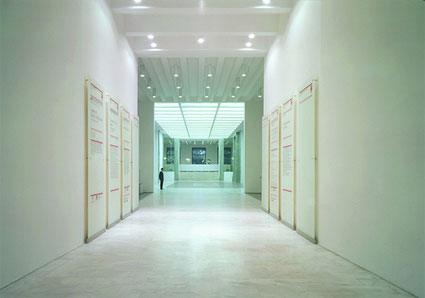 Triennale Milano, entrance view. Photo by Gabriele Basilico
Triennale Milano, entrance view. Photo by Gabriele Basilico
Launched in the wake of the Stuttgart Weissenhof –an estate of working class dwelling which was built in Stuttgart in 1927, the opening exhibition at the Palazzo back in 1933 was dedicated to the theme of housing.
One of the Triennale’s Summer exhibitions is revisiting the theme of affordable housing under a more contemporary side. Casa per tutti is pressing architects to give their attention to a theme that was central in the inter-war and post-WW2 reconstruction periods and is once again crucial in the current crisis of the postmodern metropolis.
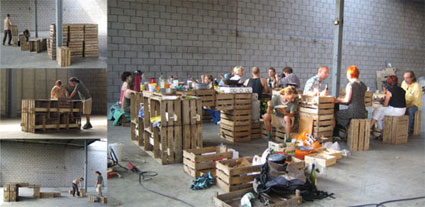 Studio Elmo Vermijs, Peopleskitchen (image at casa)
Studio Elmo Vermijs, Peopleskitchen (image at casa)
The Milan exhibition is one of the many i’ve seen on a topic which is proving quite popular these days (only in Milan i have visited two shows related to the same issue: Alternative Living Strategies and Lucy + Jorge Orta’s Antarctica expedition). The Italian Pavilion of the Architecture Biennale in Venice (September 14th to November 23rd 2008), entitled HOUSING ITALY. 12 Projects for Inhabiting and Re-inhabiting the City, will be concerned with a similar theme. In spite of its weaknesses (it’s a bit confusing, poorly distributed in space, lacking in strong focus), the Milan show makes pertinent points, displays some fascinating projects and draws meaningful parallels between past works and contemporary prototypes.
Social housing today faces new challenges: the fragmentation of societies, waves of migration and their impact on local cultures, an increase in mobility, the awareness of the limited nature of resources, the need for higher compatibility between building and nature, and the necessity to “invent” more flexible and ephemeral spaces that would better respond to the needs and cultures of their users.
In CASA PER TUTTI, past examples of the approach are exhibited side by side with a wide range of contemporary dwelling solutions, from emergency housing to self-built houses, houses for specific users (student housing, hostels for girls, nomads’ houses, workers’ housing, the wearable house etc.), including research by artists who have put this issue at the centre of their work.
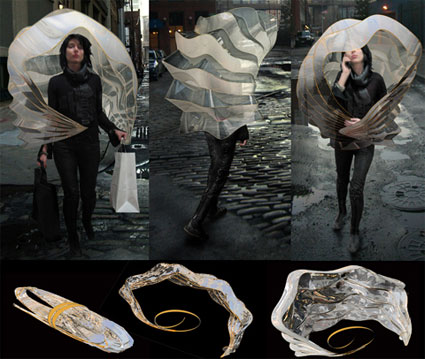 Acconci Studio, Umbruffla: Renderings & Notes, 2005. Kenny Schachter ROVE Gallery
Acconci Studio, Umbruffla: Renderings & Notes, 2005. Kenny Schachter ROVE Gallery
Anything by Vito Acconci is bound to get all my attention so i’ll kick of the list of projects i most liked with Umbruffla. Conceived by Studio Acconci, this is a new umbrella you could wrap yourself up in. Fix one end to your waist, the other to one wrist, so that both hands are free. Wearing it, you could dodge a passer-by, turn it windward and even welcome a companion under it with you. Umbruffla is made from two way mirrored mylar. From outside the surface is mirrored, so while you can see through from inside, you would be camouflaged by the reflections of the city which shimmers on you as you walk.
The name of the object comes from English – ‘ruffle’. When the object is closed, “the ruffles are gathered into a ruffle”, but, when opened, “the ruffles unfold, fan out, spring out, into an umbruffla.”
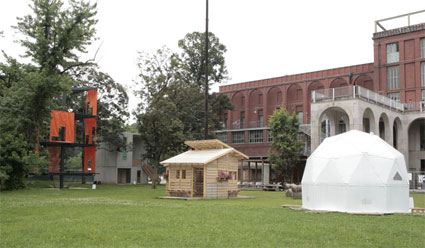 Image at casa
Image at casa
Massimiliano Fuksas, MVRDV, Jean Nouvel, Kengo Kuma, Alejandro Aravena, Cino Zucchi and other key architects were commissioned the building of a housing model which the Triennale exhibits in its garden.
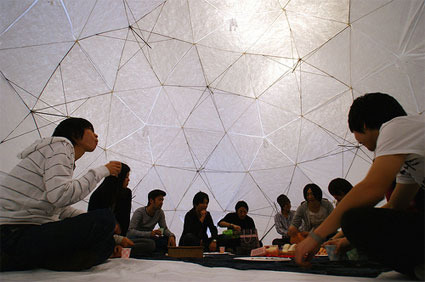 Kengo Kuma, Umbrella House
Kengo Kuma, Umbrella House
One of these prototypes is Kengo Kuma‘s Umbrella House. Like Studio Acconci, the Japanese architect modified umbrellas but this time in order to build a fast, modular and cheap shelter. Zippers along the umbrellas outer edges are zipped together to create a shelter.
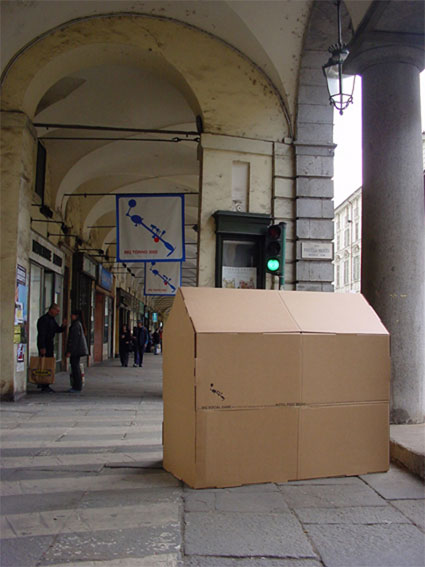 Oskar Leo Kaufmann, Carton House, 2002.
Oskar Leo Kaufmann, Carton House, 2002.
Oskar Leo Kaufmann’s Carton House was an artistic proposal for an Art Biennale held in Turin a few years ago. The minimal house wasn’t meant as an actual prototype for living on the cheap but as a way of giving visibility to the people who actually have to sleep in cardboard on the street.
The Carton House is foldable, weights 12kg and measures 1.00×0.66×0.20m. Once unfold, the living space measures 2×1×1.75m.
The Austrian architect also develops affordable and easy to mount prefab houses such as the System 3 House, that he designed together with Albert Rüf for MoMA’s Home Delivery exhibition.
Installation of the SYSTEM3 project, as part of the exhibition Home Delivery
The project evokes earlier examples of ready-to-assemble dwellings such as Sears Roebuck’s mail order houses.
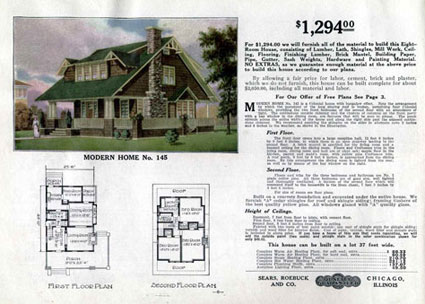 The Arlington (Model No. 145); $1,294 to $2,906 (via Sears archives)
The Arlington (Model No. 145); $1,294 to $2,906 (via Sears archives)
The Casa Per Tutti exhibition was divided in a series of sections. The Micro/Macro one reflected on two apparently opposite but in reality complementary ways of envisioning the habitat: the tiny one-person living unit and the large-scale complex of urban building.
The best example of Micro Macro is Le Corbuiser’s prototype of the Maison Domino micro-house, which develops and becomes the repetitive element of the famous Macro-house Unité d’Habitation in Marseille.
Contemporary examples of Micro-Houses include Atelier Van Lieshut, Andrea Zittel, the wearable houses of Kosuke Tsumura and Lucy Orta but also altro_studio‘s Inflatable House.
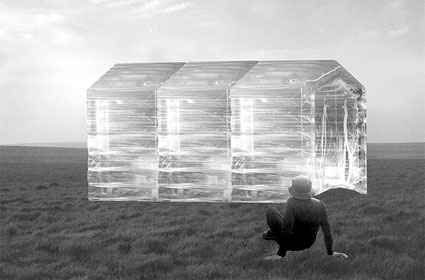 Anna Rita Emili (altro_studio), Casa gonfiabile (Inflatable House), Roma 2001.
Anna Rita Emili (altro_studio), Casa gonfiabile (Inflatable House), Roma 2001.
Like many post-Archigram inflatable projects, this clearly evokes the Cushicle. The structure clearly refers to a traditional house style. It is composed of three inflatable elements anchored on the ground by steel platforms, zipped together, and set in such a way as to prevent that water soaks into the walls. Once the length of the house has been determined, each module is concluded in non-inflatable plugging panels, that can contain a door or window as needed. These elements, which allow for the ventilation of the internal space, are characterized by a side zip closing system.
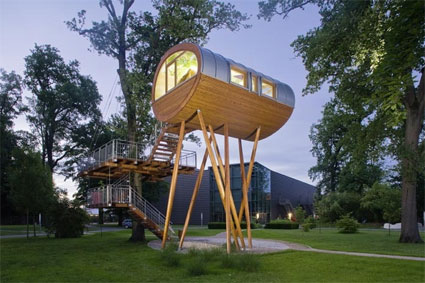 Baumraum, Tree House
Baumraum, Tree House
Some of the works, far from being designed as simple make-do for people whose lifestyle is on the margin of society, can actually confer them some dignity. See for example Baumraum‘s Tree Houses.
At the other end of the spectrum are the macro buildings made of micro housing units which, unlike many of their predecessors, rise with so much grace and appeal on the urban landscape that they make us dream of a new sense of collective habitat. Examples are the ‘Whale‘ installed by Cie on Amsterdam canals or the colourful blocks of MVRDV‘s Mirador in Madrid.
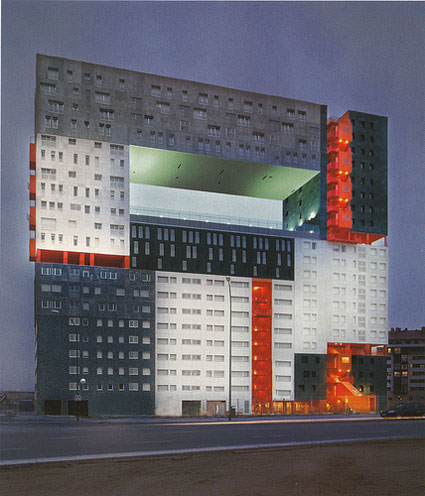 MVRDV, Mirador, Madrid 2006
MVRDV, Mirador, Madrid 2006
To those new paradigms of urban dwelling in massive structures can be added the more theoretical research of architectural studios like Dogma.
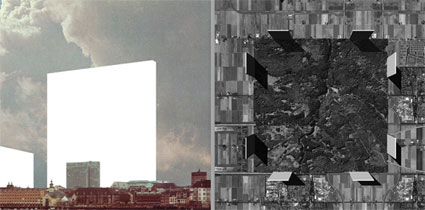 Dogma, Stop-City
Dogma, Stop-City
The Italian architects were showing an utopian concept called Stop-City, a city that develops vertically in an archipelago of dense urban island.
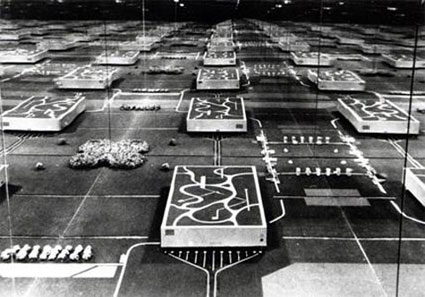 Archizoom, No Stop City, 1968
Archizoom, No Stop City, 1968
The project holds an ironic mirror to Archizoom‘s No Stop City , a 1969 concept that critiques the ideology of architectural modernism by pushing it to absurd limits. The city they envisioned had no boundaries either, but it grows horizontally, is artificially lit and air-conditioned.
That was just a partial, subjective, quick and dirty overview of the show, there’s tons more to learn and see over there. My images.
Casa per Tutti is on view at the Triennale di Milano until September 14, 2008. And i just learned that if you visit the Triennale in August you’ll be granted a free entry to all their exhibitions.
Previous exhibitions seen at the Triennale: Fabrica – Gli Occhi Aperti, Beautiful Losers: : Contemporary Art and Street Culture.
Related entries: Alternative Living Strategies, Lucy + Jorge Orta’s Antarctica expedition, the Shellhouse, Several ways to wear a mosque, Urban Nomad Shelter, paraSITE shelters, the Homeless Vehicle, Design for “urban nomads”, etc.
